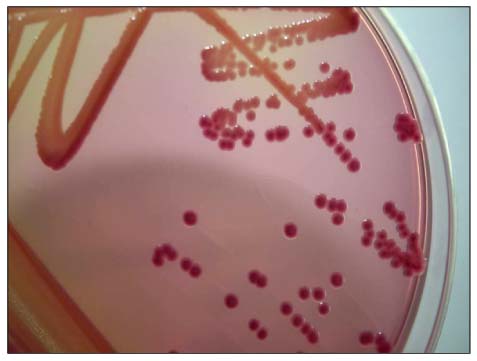J Korean Surg Soc.
2009 Apr;76(4):221-224. 10.4174/jkss.2009.76.4.221.
Is the Yersinia enterocolitica Possible Infectious Agent in Acute Appendicitis?
- Affiliations
-
- 1Department of Surgery, Eulji Hospital, Eulji University College of Medicine, Seoul, Korea. kdh2109@eulji.or.kr
- 2Department of Gatroenterology, Eulji Hospital, Eulji University College of Medicine, Seoul, Korea.
- 3Department of Laboratory Medicine, Eulji Hospital, Eulji University College of Medicine, Seoul, Korea.
- KMID: 1465059
- DOI: http://doi.org/10.4174/jkss.2009.76.4.221
Abstract
-
PURPOSE: With increasing frequency, Yersinia enterocolitica is being recognized as an important bacterial cause of acute gastrointestinal infection with abdominal pain. In addition, the association of Y. enterocolitica infections with acute appendicitis has been suggested. This study was undertaken to ascertain whether Y. enterocolitica is a possible infectious agent in acute appendicitis.
METHODS
Between December 2007 and April 2008, 162 patients who underwent appendectomy for presumed appendicitis, enrolled in this prospective study. After surgical excision of appendix, a portion of each specimen was cultured for Y. enterocolitica with highly selective media (Cefsulodin-Irgasan-Novobiocin agar).
RESULTS
Pathologically, 150 of the patients had appendicitis and 12 patients had normal appendices. Only one of the 150 patients (0.7%) with appendicitis was found to be culture positive for Y. enterocolitica, while it was not detected from normal appendices.
CONCLUSION
The authors were unable to implicate Y. enterocolitica as a major pathogen in acute appendicitis within the Seoul area. However, we thought there to be more need for investigation for association of Y. enterocolitica with acute appendicitis over a broader area and season.
MeSH Terms
Figure
Reference
-
1. Kim MS, Hong BH, Kim DH. Management of cecal diverticulitis that's misdiagnosed as acute appendicitis. J Korean Surg Soc. 2007. 73:146–150.2. Wangensteen OH, Bowers WF. Significance of the obstructive factor in the genesis of acute appendicitis: an experimental study. Arch Surg. 1937. 34:496–526.3. Gray GF Jr, Wackym PA. Surgical pathology of the vermiform appendix. Pathol Annu. 1986. 21(Pt 2):111–144.4. Cover TL, Aber RC. Yersinia enterocolitica. N Engl J Med. 1989. 321:16–24.5. Bennion RS, Thompson JE Jr, Gil J, Schmit PJ. The role of Yersinia enterocolitica in appendicitis in the southwestern United States. Am Surg. 1991. 57:766–768.6. Ahn SH, Suh JT, Chi HS, Lee JD. Five cases of Yersinia enterocolitiea enteritis in adults. Korean J Pathol. 1981. 15:449–457.7. Lee JH, Rhee PL, Lee JK, Lee KT, Son HJ, Kim JJ, et al. The etiology and clinical characteristics of mesenteric adenitis in Korean adults. J Korean Med Sci. 1997. 12:105–110.8. Shin HM, Jeong HS, Wang HD, Lee YD, Sung RH. Mesenteric lymphadenitis due to Yersinia enterocolitica: a case report. Korean J Pathol. 2000. 34:1022–1024.9. Vantrappen G, Geboes K, Ponette E. Yersinia enteritis. Med Clin North Am. 1982. 66:639–653.10. Saebo A. The Yersinia enterocolitica infection in acute abdominal surgery. A clinical study with a 5-year follow-up period. Ann Surg. 1983. 198:760–765.11. Attwood SE, Cafferkey MT, Keane FB. Yersinia infections in surgical practice. Br J Surg. 1989. 76:499–504.12. Winblad S. Erythema nodosum associated with infection with Yersinia enterocolitica. Scand J Infect Dis. 1969. 1:11–16.
- Full Text Links
- Actions
-
Cited
- CITED
-
- Close
- Share
- Similar articles
-
- Mesenteric Lymphadenitis Due to Yersinia enterocolitica: A case report
- Terminal Ileitis Caused by Yersinia enterocolitica and Presents with Intussusception Mimicking Crohn's Disease
- In-vitro cell invasiveness and cytotoxicity of CRMOX-posive and- negative strains of yersinia enterocolitica grown at 26'C and 37'C
- Biotype, serotype and antimicrobial susceptibility of yersinia enterocolitica isolated from cattle
- A Case of Yersinia enterocolitica Enterocolitis Accompanied by Colonic Adhesion after Surgery for Uterine Myoma in an Adult Patient



